Nintendo's Development Secrets, Cloud Gaming & new Killer NIC - GDC '09
by Anand Lal Shimpi & Derek Wilson on March 26, 2009 12:00 AM EST- Posted in
- Trade Shows
OnLive: Gaming Without the Hardware Requirements
I first read about OnLive before I ever set foot on the GDC show floor thanks to Dean Takahashi’s story on the service. If you haven’t read about it, here’s what it does.
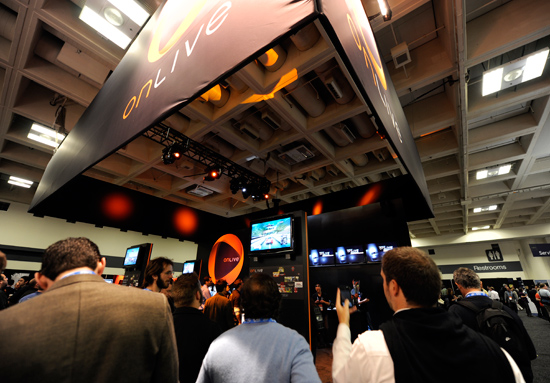
Today when you go to play a 3D game like BioShock or Unreal Tournament III, the rendering is done on your PC or console. There’s a reasonably powerful GPU and a fast CPU in your machine and it goes about calculating the color of every pixel on your screen and the impact of every explosion. The more demanding the game, the more powerful your CPU and GPU have to be.
Instead of doing that rendering locally in your home on your PC or console, OnLive seeks to do it remotely on powerful high end servers and simply stream the rendered frames to you, compressed, over the Internet.
OnLive claims that its compression technology is good enough to deliver HD resolution gaming over a standard Internet connection, without the need for a high speed PC or console. The bandwidth requirements are about 1Mbps for a 640 x 480 resolution and 5Mbps for 1280 x 720. The data compression algorithms are adaptive, so if you have poor network conditions the quality of the video sent to your screen will go down to compensate.
The benefit of OnLive is that you can play any title on any platform. OnLive will be supported on PCs, Macs and directly connected to a TV using a very light hardware client. There’s no word on pricing yet.
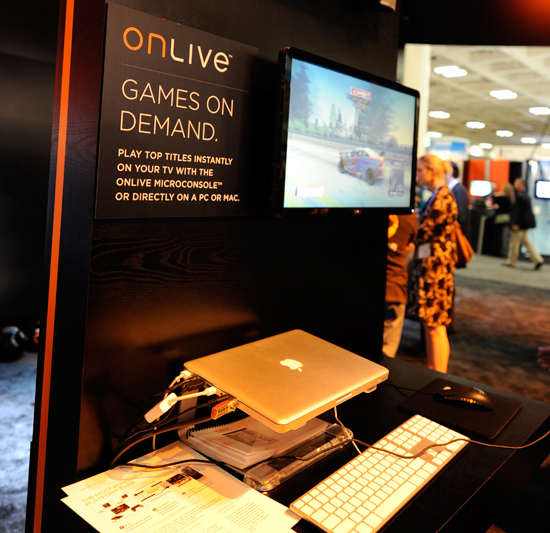
OnLive running on a MacBook
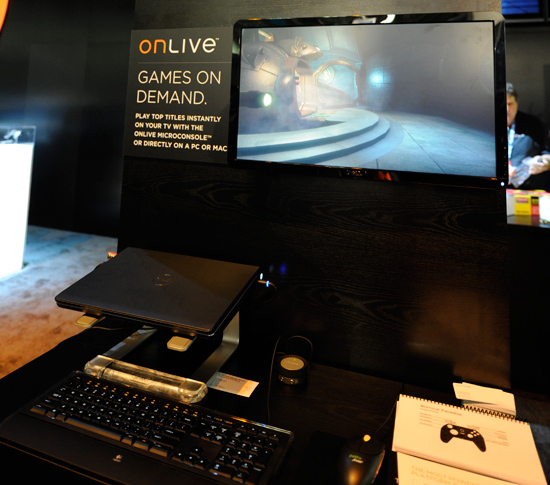
...and on a Dell notebook
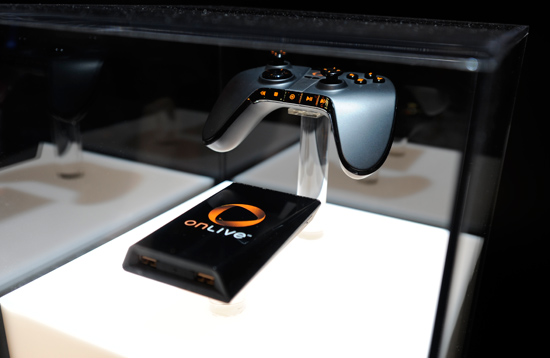
...or on the OnLive "console" hardware; basically a video encoder, ethernet and a USB port.
OnLive does have major game developer support. The list of developers includes the big names: EA, Ubisoft and Epic.
I played BioShock at OnLive’s booth. The game was streamed to me over the Internet and for the most part, it looked and felt like BioShock. The game didn’t look as good as running on a PC with a high end graphics card, and it felt like there was some sort of frame rate smoothing going on, but the technology worked.
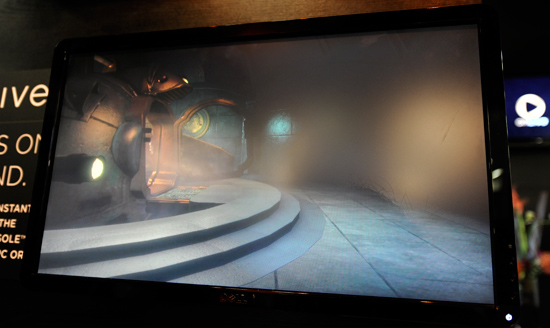
BioShock over the Internet. Cool.
The implications are huge. You wouldn’t need a high end PC or console to play the latest games. Game prices could be cheaper thanks to cutting out publisher and retail store overhead. Cross-platform multiplayer gaming would now be possible; if BioShock were a multiplayer game, you wouldn’t have to worry about which version was being played - you could play on your Mac with your friend on his/her PC.
OnLive is supposed to launch by the end of 2009.










38 Comments
View All Comments
blagishnessosity - Thursday, March 26, 2009 - link
The way I see it, broadband speeds are decreasing. A decade ago when my family first got road runner, few other families in the neighborhood had it, so there was not nearly the amount of network usage that we see today. Now, everyone has broadband and usage is high, slowing down the network. Now the ISP's are charging more for inferior speeds. In my experience, bandwidth tests back then yielded much higher speeds then they do now. And not just that, I pay more money for less speed (I've always used road runner). So, maybe the technology exists for higher speeds now, but you have to pay a high premium for them. There doesn't appear to be enough competition in the ISP market for this trend to change anytime soon.XiroMisho - Thursday, March 26, 2009 - link
I originally thought this was bloatware... until I tried to do voice chat on a system with a sub par sound card. For the price, and the fact it has voice chat support... then okay, vs buying a better sound card on PCI-E (Which... doesn't exist for under a $150, thank you lethargic sound card community...), this may be worth it... of course going to wait till the price drops to about $79.99.Calin - Thursday, March 26, 2009 - link
This won't help if you're having a sub par sound card. It's like buying larger tires for better grip when you're using a Yugo to tow a large trailer, or somethingBigfootSean - Tuesday, March 31, 2009 - link
Well, sorta. Currently, lots of game voice apps rely on the CPU to do all the encode / decode operations required for gaming voice chat. Sound cards do a good job at DirectSound / EAX sort of stuff, but when it comes to more random stuff like voice, both the apps and the cards develop out of sync.It makes sense for us to do this (and sign up as many partners as possible) because voice chat is a network app that should run on the NIC. Let the CPU worry about the game, let the audio card worry about the explosions and effects, and let the network processor slice, dice, decode, encode and send.
Combined with hardware bandwidth control, this means that your game will never step on your voice chat, and vice versa, assigning clear priorities to each so that neither becomes scrambled.
Thanks for the opportunity to reply!
Lifted - Thursday, March 26, 2009 - link
I still have to play with my friends wii's. :(NewBro - Thursday, March 26, 2009 - link
I'm sorry but am I the only one who thinks the whole OnLive gaming on internet is a terrible idea to start with? First of all the latency issue, and the whole thing running through the internet just doesn't sounds all that great to me. I mean would you want to be interrupted in the middle of a Boss fight in Resident Evil 4 due to a bad connection?xahydra - Sunday, March 29, 2009 - link
Yeah, this whole cloud stuff is getting a little wacky now... Sure there are some really useful services, but it bothers me to see some people get so excited about handing their hardware over little by little and depending on someone else to run their software. I don't want a future filled with dumb terminals that can be managed and controlled more than ever by someone else. The P in PC is for Personal. Its bad enough I have to ask for Microsofts permission to activate my OS when I swap out a peice of hardware. I don't want "subscription software" and "on-demand" gaming... I can pull out my old copy of Freespace 2 and play it at will because it's MINE, I don't have to navigate to the "classics channel" and pay to play over a streamnubie - Friday, March 27, 2009 - link
Personally the ramifications of this are easy to see if you imagine that you could have a server that streams the game to any display you want in or around your house.Instead of having a monster gaming machine tethered to a desk making heat and noise you could have wireless handheld consoles, from the iPhone to the PSP/DS, or even something much slimmer with a 10" screen on a magnesium or aluminum chassis and hours upon hours of battery life. Not to mention streaming to displays all over your house, from the projection room to the kitchen.
What about inviting people over for a "LANparty" without the LAN. Imagine the latency reduction of having everyone on the same system. I can, I already use nVidia dual-view to load up games with split-screen and split-controls onto my PC, and it is a blast (not that these games are common, only a handful of titles at best.)
SLi and Crossfire don't seem particularly interested in allowing users to span 2-8 displays of multi-player goodness from one machine, even though the results are stunning.
The0ne - Thursday, March 26, 2009 - link
I don't think it will work at all when there are tons of users. Sure a few demos and players here seems fine now but just wait til you're at WOW numbers :)Samus - Thursday, March 26, 2009 - link
It makes sense for games like World of Warcraft where latency isn't a big deal...although WoW isn't very graphically intensive to begin with so the service is for the most part unneccessary.FPS's = I agree with you. Latency is ALREADY a problem in deathmatch, and that's measured in milliseconds. I'm sure the video latency will be at least a second.